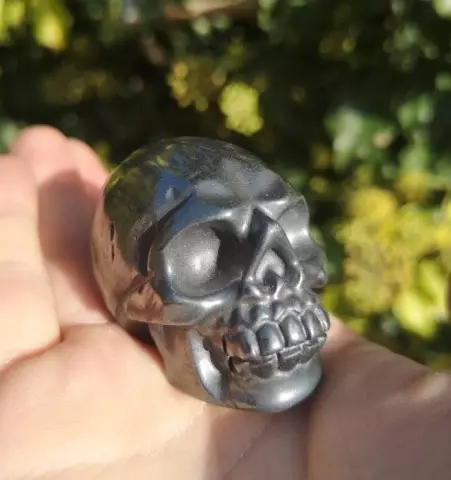- Author Curtis Blomfield [email protected].
- Public 2023-12-16 20:44.
- Last modified 2025-01-23 17:01.
If you carefully study the human skull, you can identify its main components. It is also worth noting that this part of the skeleton includes mixed flat and pneumatic bones. Each of the components has an interesting complex structure that requires special attention.
General anatomy of the head skeleton
The topography of the skull allows you to evaluate the abundance of its functions: it is a support for the initial elements of the respiratory tract (nasal and oral cavity), the digestive tract. Moreover, this part of the skeleton plays the role of a container for the sense organs and the brain.

The skull can be divided into two main sections: facial and cerebral. The border between them is located on the upper edge of the orbit: it follows along it and passes through the fronto-zygomatic suture. As a result, the line of separation reaches the top of the mastoid process and the opening of the ear canal.
The best way to study in detail the structure of the human head is the topography of the skull. The anatomy of this part of the body in this case becomes much clearer. Indeed, with a separate study of the bones, as a rule, various important formations (holes and channels) lying at the junctions are left aside.
Brain Area
In fact, the cranial cavity iscontinuation of the spinal canal. This part of the skeleton consists of four unpaired bones (occipital, sphenoid, frontal and ethmoid), as well as two paired ones (temporal and parietal).

If you pay attention to the brain section, you can see that it has an ovoid shape and is divided into a base and a vault (roof). The role of the border between them is played by a plane that can be drawn from the external eminence of the occipital bone to the superciliary arches.
Structure of vault and base
The roof consists of the occipital, temporal, parietal bones and frontal scales. The topography of the brain skull allows you to see that all these components have a special structure - two plates. One of them is facing the inside of the head, the second is the outside.
The lowest part of the skull, called the base, also has an outer and inner surface. Here are the posterior, anterior and middle cranial fossae. They are located in the region of the inner surface of the base. In the case of the outer part, the topography of the base of the skull allows you to see on it the condyles and bone processes, apertures, and choanas.

As you can see, the department data structure is quite complex.
Basic bones of the cerebral skull
Studying the key components of this part of the skeleton of the head, one cannot ignore the dorsal surface. This is where the occipital bone is located. Outside, it has a convex shape, the inside is concave. This bone is bounded by a largeoccipital foramen connecting the spinal canal with the cavity.
Topography of the cerebral part of the skull will help to find the temporal bone, which is a pair and at the same time the most complex. It is in it that the organ of balance and hearing is located. This area of the head skeleton can be divided into three parts: stony, tympanic, and squamous.
Several important channels run inside the temporal bone: musculo-tubal, carotid, facial, mastoid tubule, etc. For this reason, injuries in this area are very dangerous.
Also, the topography of the skull allows you to notice the sphenoid bone in the brain part. It consists of three paired processes and a body. A is located between the frontal (front) and occipital bone (rear). The medial plate, which is part of the pterygoid processes, forms the nasal cavity.
In the brain part of the head skeleton there is also a frontal, parietal and ethmoid bone.
Topography of the facial skull
If you pay attention to this part of the head skeleton, you can see a rather complicated structure. It’s worth starting with the upper jaw, which is a steam room and consists of four processes (palatal, frontal, zygomatic, alveolar) and the body. In the body itself, the nasal, orbital, infratemporal and anterior surfaces are distinguished.

It is worth noting that the upper jaw is involved in the formation of the nasal cavity, the pterygo-palatine and infratemporal fossae, as well as the mouth and orbits.
The topography of the skull makes it possible to determine the zygomatic bone. It is also a steam room and performs the function of strengthening the front part. This component of the skeleton of the head is connected to the frontal, temporal bones and the upper jaw.
The palatine bone also plays an important role. It can be found behind the upper jaw. The boundaries of this element of the skull extend beyond the anterior part of the pterygoid process of the sphenoid bone. The palate area consists of perpendicular and horizontal plates.
The lower jaw, in turn, is an unpaired bone and the only moving element of the head skeleton. It has two branches and a body. Together with the temporal bone, it forms the temporomandibular joint. The body itself has a curved shape and consists of an outer convex and an inner concave surface.
Also in the facial part of the skeleton of the head there is a nasal, lacrimal, hyoid bone, vomer and condylar process.
Thus, the topography of the skull allows us to conclude that this part of the human body is one of the most complex and performs supporting and protective functions, and also plays an important role in the respiratory and digestive systems.






